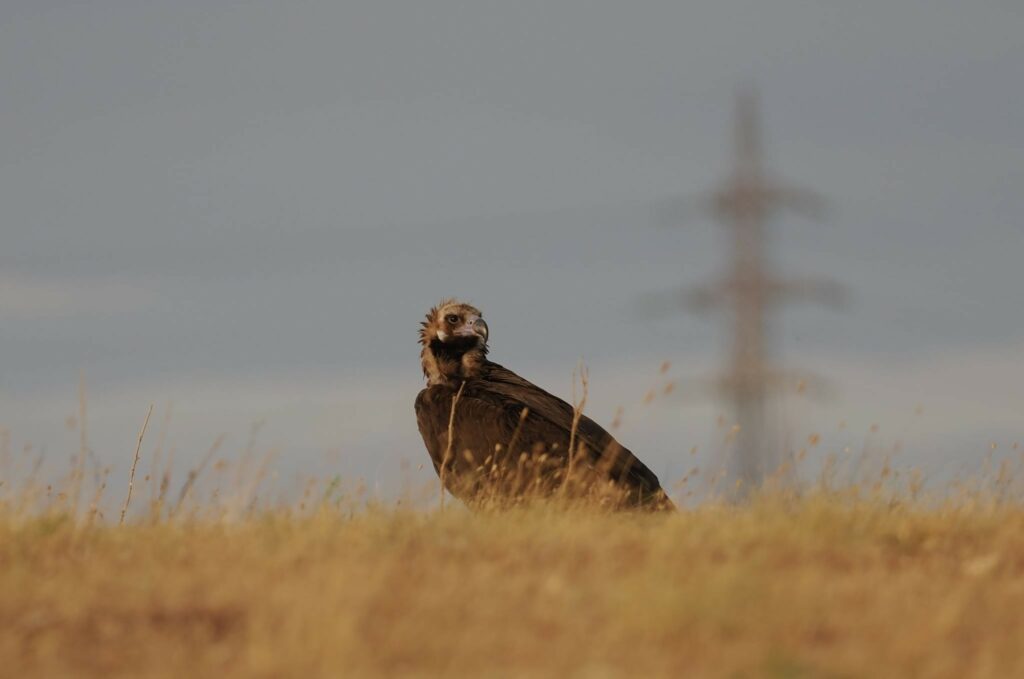
Two Cinereous Vultures recently hatched in the Sierra de la Demanda! This hatching is a milestone, since this species has not bred in the entire Iberian System for more than half a century.
Cinereous Vulture reintroduction in the Dierra de la Demanda
The hatching of these two Cinereous Vulture chicks in the Burgos, sector of the Sierra de la Demanda, took place thanks to important conservation and reintroduction efforts. GREFA, with the collaboration of the Junta de Castilla y León and the Gobierno de La Rioja released Cinereous Vultures in 2017 at the municipality of Huerta de Arriba (Burgos) to help bring the species back to the region.
GREFA’s Monachus Project released almost fifty Cinereous Vultures in the Sierra de la Demanda during the last three years, which formed nine pairs. Six of these pairs, situated in Burgos and one in La Rioja, have incubated their clutch (a single egg) during the 2020 breeding season with favourable results — for the first year, the species successfully bred in the Sierra de la Demanda!
The pair formed by two Cinereous Vultures reintroduced in 2017, the male “Acebo” and the female “Arca”, was the first to see their chick hatching on 30 April. The chick of the second pair, male “Arrañón” and the female “Barbojeda”, the former released in 2017 and the latter came from another colony, hatched on 14 May. The pair that is still waiting for their chick to hatch is formed by the male “Benigno” and the female “Canaleja”, both coming from other colonies. The three remaining pairs, although they have begun to incubate, have failed, perhaps due to the inexperience of the young and the inclement weather this spring.

The nests of the two chicks that have already hatched are located in pine trees in the province of Burgos; one is natural while the other is an artificial nest. The other nest is located in a Scots pine tree in Burgos territory, and it is artificial.
Source: GREFA
Cinereous Vulture comeback in Europe
The Cinereous Vulture population significantly decreased in the past 200 years due to several threats, and became extinct in some regions.
The Monachus Project releases captive-bred and wild-hatched Cinereous Vultures in the Sierra de la Demanda to connect the large Cinereous Vulture colonies in the centre and south of the Iberian Peninsula with those being established in France and other countries.
In France, the species went extinct over 100 years ago. To bring it back, a project led by LPO Provence-Alpes-Côte d’Azur and Vautours en Baronnies launched a reintroduction project. So far, the project released 41 Cinereous Vultures in the Gorges du Verdon and 45 in Baronnie provençales. Thanks to these actions, the first breeding in Baronnies happened in 2010, while in the Gorges du Verdon it was registered in 2013.
In Bulgaria, the Vultures Back To LIFE aims to establish a nesting population of this species that went extinct in the country by tackling main threats and releasing Cinereous Vultures. The goal is to restore the connections between the sub-populations of this species in the Balkans (Greece), Crimea, the Alps and the Iberian Peninsula. So far, the population of the species is gradually increasing, with the first pair officially formed in 2020 by two reintroduced vultures since the species extinction in Bulgaria.
In Portugal, Cinereous Vulture naturally recolonised some of their former ranges. An increasing population in Spain saw the species regularly visiting Portugal to forage, with the first pair breeding in central Portugal (Tejo Internacional) in 2010 (where now there is a small colony of more than fifteen pairs), and then in north-eastern Portugal (one single pair). And in 2015, the species recolonised Herdade da Contenda in south-eastern Portugal, and has bred there successfully ever since – there are at least eight breeding pairs there now. A range of projects support the conservation of the Cinereous Vultures in Portugal such as the cross-border LIFE Rupis project in the Douro Canyon and the Habitat Lince Abutre project in southern Portugal.
This breeding success is yet another conservation optimism story proving that vulture conservation and reintroduction projects work!
Sign up to our newsletter and never miss any vulture news!




